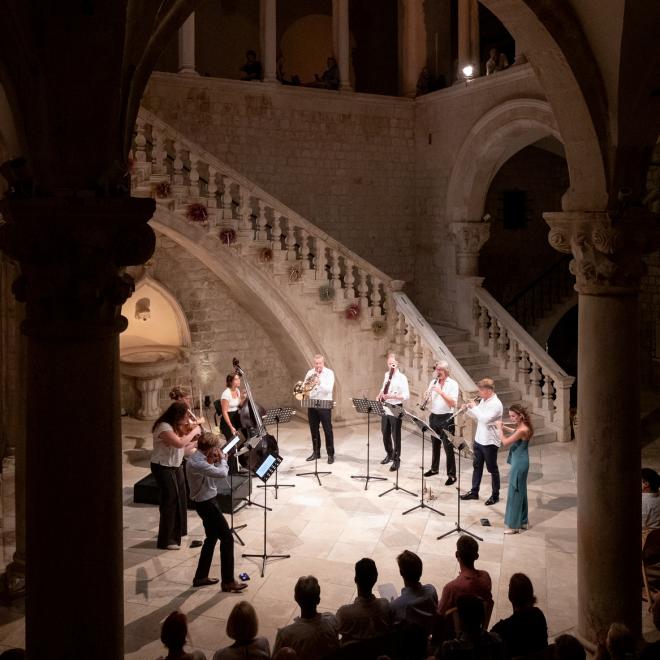
- More
- Performances
- Galleries
- Artists
Camerata RCO
PROGRAMME:
Nino Rota: Nonetto
Allegro
Andante
Allegro con spirito
Canzone con variazioni
Vivacissimo
Johannes Brahms: Serenade no. 1 in D major, op. 11
Allegro molto
Scherzo. Allegro no troppo – Trio
Adagio non troppo
Menuetto I – Menuetto II
Scherzo. Allegro – Trio
Rondo. Allegro
Ensemble:
Marc Daniel van Biemen - violin, Santa Vižine - viola, Maartje-Maria den Herder - cello, Lucia Mateo - double-bass, Luna Vigni – flute, Alexander Krimer - oboe, Hein Wiedijk - clarinet, Emile Souvagie - clarinet, Jos de Lange - bassoon, Jasper da Waal - horn
--
MORE ABOUT THE PROGRAMME:
Notes by Dina Puhovski
Some of Nino Rota’s (Giovanni Rota Rinaldi, Milan, 1911 – Rome, 1979) countless works are so famous that they completely overshadow everything else he composed: He wrote scores for around 150 films, including those by Federico Fellini and Francis Ford Coppola’s The Godfather (including one of the most famous melodies in the world, later lyricized in English into ‘Speak Softly, Love’). Apart from his skilfully written, eclectic music for the cinema, he wrote numerous other works: ten operas, three symphonies, music for ballet and theatre productions, chamber and numerous choral works, three piano concertos, as well as concertos for cello, double bass, trombone, bassoon and harp.
He composed since childhood, surrounded with music thanks to his pianist mother, and wrote his first opera and oratorio before he turned fifteen. He studied music in Milan, Rome and, encouraged by Arturo Toscanini, at the Curtis Institute of Music in Philadelphia, where he was introduced to the music of George Gershwin, ‘The Great American Songbook’ and music of American film composers. In Italy, he served as director of the Liceo Musicale, a conservatory in Bari. He composed music for Italian films from 1933, at the same time writing operas and other works. The year 1952 marked the beginning of his legendary thirty-year collaboration with Federico Fellini, on films such as La dolce vita, La strada and Amarcord; he also collaborated with Luchino Visconti and Franco Zeffirelli. He won a Grammy for the score of The Godfather, and an Oscar for The Godfather, Part II, in 1975.
His other, non-film works are also characterised by eclectic style, a combination of Italian and classical music with American influences in a variety of genres, as well as memorable melodies, simplicity, conciseness, humour and – gestures. Rota wrote the Nonet in 1959, and worked on it for the next fifteen years. Nonets are not a common form, but that year another composer, Bohuslav Martinů also wrote a nonet for the same ensemble – flute, oboe, clarinet, bassoon, horn, violin, viola, cello and double bass.
Rota’s piece is expansive, composed of five movements with a variety of contrasting moods – lightheartedness, melodrama, humour, frenzy, always demanding virtuosity. Or, as Alan Young, author at Lucid Culture wrote (in an article about a recording of the Nonet): ‘the group parses heroic symphonic drama along with a waltzing jubilation and a subtle turn toward unease before the good guys win.’
Johannes Brahms (Hamburg, 1833 – Vienna, 1897) began his musical training in his hometown and was teaching music and giving piano performances since he was twelve. Brahms’s music as it is known today is most likely only a third of his total output, since he often destroyed the works he did not consider good enough, especially those written in his youth. In an attempt to motivate him, the esteemed violinist and Brahms’s friend Joseph Joachim referred him to Franz Liszt and Robert Schumann. As it turned out, he and Liszt did not have much in common, eventually they even became famous opponents, as Brahms was considered a classicist, a historicist, and Liszt a representative of the New German School (with Wagner). Nevertheless, Schumann instantly accepted and encouraged him to compose, he wrote about him, while Brahms also befriended Schumann’s wife Clara, a pianist and composer – their relationship being an inexhaustible source of speculation for Brahms’s biographers, especially after Schumann’s death in 1856.
Brahms wrote four symphonies, Violin Concerto, A German Requiem, nearly 200 art songs, pieces for solo piano and numerous chamber works – string and piano quartets and quintets, sextets, cello sonatas, clarinet chamber music. His works are often branded as classicist, academic, but painted with Romantic passion; on the other hand, speaking on the occasion of the centenary of Brahms’s birth, the ‘father of atonal music’, Arnold Schönberg called him ‘a great innovator in the realm of musical language’ who was in fact ‘a great progressive.’
Before introducing the innovations he is known for today, young Brahms wrote two Serenades, Op. 11 and Op. 16. Serenade, Op. 11, is his first published orchestral work, the first without the piano. Premiered in Hannover in 1860, he sketched it during his winters in Detmold while he was teaching music at the court of Prince Leopold III.
Serenade, Op. 11, is one of those works where a composer looks back on the generations that composed before him, in this case, Brahms’s homage to the serenades and symphonies of Mozart, Haydn, Beethoven and Schubert. It is nevertheless influenced by Romanticism, with expanded harmony. His looking to old forms created a joyous, even pastoral, sonata-form first movement, with elements of folk dance, followed by a sombre scherzo, an idyllic third movement with songlike melodies, straightforward minuets and a stately scherzo, concluding with an expectedly jubilant rondo. At first, Brahms thought that the premiere was not going well, but, as he later stated, in the end, applause ‘persisted until I came out and down in front.’
The original Serenade was written for nine musicians – another nonet – but Clara Schumann and Joseph Joachim persuaded Brahms to rework it for a larger orchestra. Clara Schumann also made sure that Brahms’s Serenade No. 1 was performed by the Vienna Philharmonic, thus ensuring its popularity: Performance of this Brahm’s piece was a condition for her own concert appearance with the Philharmonic.
--
Photo (c) Hans Van Der Woerd
--

- 18. August 2023./ Friday / 21:30 Rector's Palace Atrium +Tickets


